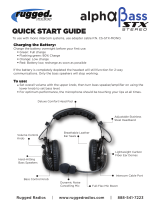
12 ML4000 User Guide
Technical Specifications
0dBu = 0.775 Vrms, +4dBu = 1.23 Vrms
Operating Levels
Channels......................................... 0dBu Headroom +21dB
Mix .................................................. -2dBu Headroom +23dB
Max XLR output .............................. +23dBu
Frequency Response Referred to 1kHz at +4dBu
Mic to main output (+40dB)............. 20Hz to 30kHz +0/-0.5dB
Line to main output (0dB)................ 20Hz to 30kHz +0/-0.5dB
Distortion @1kHz +14dBu
THD+noise ...................................... < 0.02%
CMRR Common mode rejection @1kHz
Mic (+40dB)..................................... > 80dB
Mic + Pad (0dB) .............................. > 50dB
Crosstalk Referred to driven channel @1kHz
Channel to channel ......................... < -95dB
Mute shutoff .................................... < -90dB
Fader shutoff................................... < -90dB
Noise Performance Measured rms 22Hz to 22kHz unweighted
Mic EIN with 150 ohm source ......... -128dB
Residual output noise ..................... < -98dBu
Mix noise, nothing routed................ < -94dBu
Mix noise, 24 channels routed ........ < -84dBu
Metering
Reading 0................. 0dBu at XLR outputs
LED meters .............. Peak reading, 3 colours
VU meters ................ Ave reading, Illuminated moving coil
Peak indicators ........ 5dB before clip, multi-point sensing
Input meters ............. 5 bar LED (signal, -6, 0, +6, peak)
Group mix meters .... 5 bar LED (signal, -6, 0, +6, peak)
Group/Mtx meters .... VU
L,R,C meters............ VU and 16 bar LED
Lamp Connectors x3
Connector ....................................... XLR-F 4pin
Rating.............................................. 12V 400mA max
Channel Filters
Slope ............................................... 12dB/oct high pass
Frequency ....................................... 20Hz to 400Hz
Mono Equaliser
HF................. +/-15dB, 2kHz to 20kHz shelf
HM................ +/-15dB, 500Hz to 15kHz bell, Q = 1 or 2
LM ................ +/-15dB, 35Hz to 1kHz bell, Q = 1 or 2
LF ................. +/-15dB, 20Hz to 200Hz shelf
Stereo Equaliser
HF................. +/-15dB, 12kHz shelf
HM................ +/-15dB, 2.5kHz bell
LM ................ +/-15dB, 250Hz bell
LF ................. +/-15dB, 60Hz shelf
Power Supply Model MPS14
Type ........................... External 2U rack or floor mount
Mains input................. 100-230V 50/60Hz universal input
Power consumption.... 500W
Full protection and fan cooling
Built-in combiner for redundant supply
Dimensions Width.............. Depth ...... .....Height
24 Channel 1196 (47”) ...... 781 (30.7”) ....282 (11.1”)
32 Channel 1451 (57”) ...... 781.......... .....282
40 Channel 1706 (67”) ...... 781.......... .....282
48 Channel 1961 (77”) ...... 781.......... .....282
Sidecar 831 (33”) ........ 781.......... .....282
MPS14 psu 483 (19”) ........ 260 (10.2”) ....
Weights 24 Channel..... 53 kg (116 lbs)
32 Channel..... 65 kg (143 lbs)
40 Channel..... 75 kg (165 lbs)
48 Channel..... 87 kg (191 lbs)
24 Sidecar...... 40 kg (88 lbs)
MPS14 psu .... 2.5 kg (5 lbs)
INPUTS:
Mic (Pad out)................ XLR.................balanced, pin2+........ 2k ohm ..............variable -60 to -10dBu ........ Max +11dBu
Mic (Pad in).................. ........................ ................................. >20k ohm..........variable -40 to +10dBu ....... Max +31dBu
Stereo A ...................... TRS jack .........balanced, tip+........... >20k ohm..........variable -18 to +6dBu ......... Max +27dBu
Stereo B ...................... XLR.................balanced, pin2+........ >20k ohm..........variable –18 to +6dBu ........ Max +27dBu
2-Track......................... TRS jack .........balanced, tip+ .......... >20k ohm..........+4dBu ................................. Max +25dBu
INSERTS:
Input send .................... TRS jack .........ground comp, tip+ .... <50 ohm............0dBu ................................... Max +21dBu
Input return................... TRS jack .........balanced, tip+........... >20k ohm ..........0dBu ................................... Max +21dBu
Output send ................. TRS jack.........ground comp, tip+ .... <50 ohm............-2dBu.................................. Max +21dBu
Output return................ TRS jack .........balanced, tip+........... >20k ohm..........-2dBu.................................. Max +21dBu
OUTPUTS:
L,R,C............................ XLR.................balanced, pin2+........ <75 ohm............0Bu ..................................... Max +23dBu
Grp/Aux 1-12................ XLR.................balanced, pin2+........ <75 ohm............0dBu ................................... Max +23dBu
Matrix 1-4 ..................... XLR.................balanced, pin2+........ <75 ohm............0dBu ................................... Max +23dBu
Direct out...................... TRS jack .........ground comp, tip+ .... <50 ohm............0dBu ................................... Max +21dBu
2-Track......................... TRS jack .........ground comp, tip+ .... <50 ohm............0dBu ................................... Max +21dBu
Local Monitor ............... TRS jack .........ground comp, tip+ .... <50 ohm............0dBu ................................... Max +21dBu
Headphones................. TRS jack .........tip left, ring right........ for stereo headphones >30 ohms





















